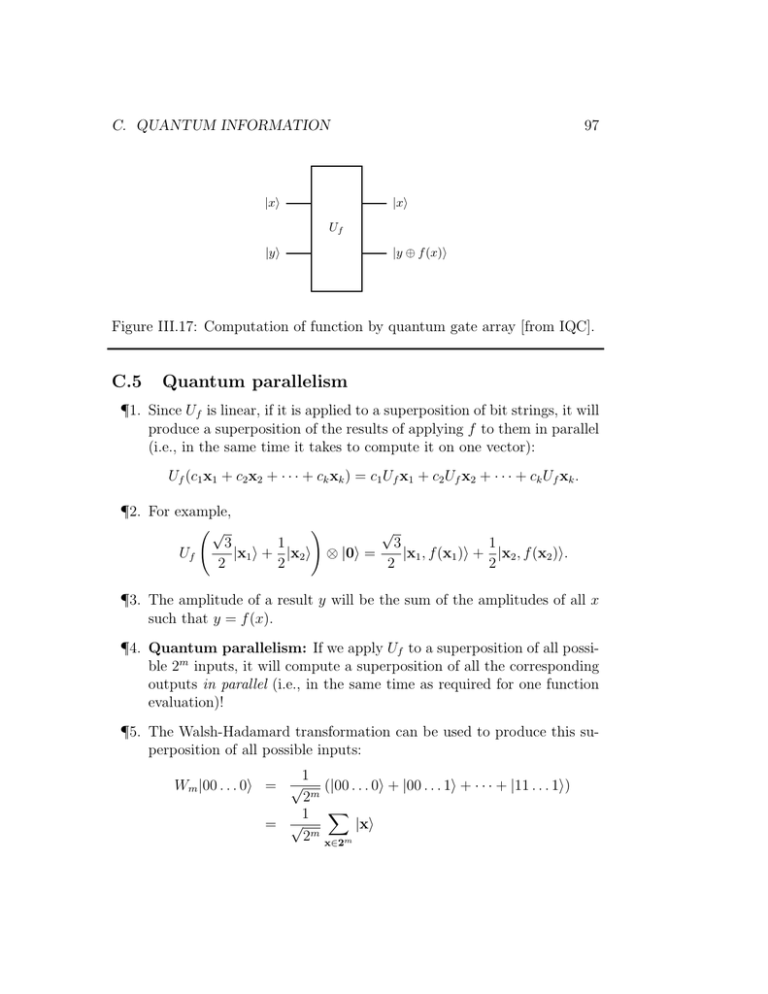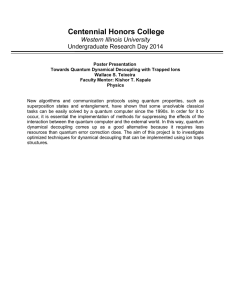·
advertisement

gates for any classically computable function. In fact, it is possible to conceive of a universal quantum Turing machine [Bernstein and Vazirani 1997]. In this construction we must assume a sufficient supply of bits that correspond to the tape of a Turing machine. Knowing that an arbitrary classical function f with m input and k output bits can be implemented on quantum computer, we assume the existence of a quantum gatearray Uf that implements f . Uf is a m + k bit transformation of the form Uf : |x, yi ! |x, y f (x)i where denotes the bitwise exclusive-OR6. Quantum gate arrays Uf , defined in this way, are unitary for any function f . To compute f (x) we apply Uf to |xi tensored with k C. QUANTUM INFORMATION zores |x, 0i. Since f (x) f (x) = 0 we have Uf Uf = I. Graphically the transformation Uf : |x, yi ! |x, y f (x)i is depicted as |xi 97 |xi Uf |yi |y f (x)i. While the T and F gates are complete for combinatorial circuits, they cannot achieve arFigurequantum III.17:state Computation ofInfunction by quantum gatetransformations array [from 7IQC]. bitrary transformations. order to realize arbitrary unitary , single bit rotations need to be included. Barenco et. al. [Barenco et al. 1995] show that Cnot together with all 1-bit quantum gates is a universal gate set. It suffices to include the following one-bit transformations C.5 Quantum ✓parallelism ◆ ✓ i ◆ cos sin e 0 ¶1. Since Uf is linear, if sin it is cos applied, to 0a superposition of bit strings, it will e i produce a superposition of the results of applying f to them in parallel for all 0(i.e., in 2thetogether a universal gates. As we shall not to obtain same with timetheitCtakes to compute it set onofone vector): see, such non-classical transformations are crucial for exploiting the power of quantum computers. U (c x + c x + · · · + c x ) = c U x + c U x + · · · + c U x f 1 1 2 2 k k 1 f 1 2 f 2 k f k. 5.2 Quantum Parallelism ¶2. For example, What happens if Uf is applied to input which is in a superposition? The answer is easy ! papplied to all basis vectors in the but powerful: since p Uf is a linear transformation, it is 3 1 3 1 superpositionU simultaneously and will a superposition results. way, |x1 i + |x2 igenerate ⌦ |0i = |x1 , fof(xthe + |xIn2 ,this f (x f 1 )i 2 )i. 2 f (x) for2n values of x in a single 2 application of Uf2. This effect is it is possible to compute called quantum parallelism. The power of quantum algorithms comes from taking quantum parallelism ¶3. The amplitude of a result y will be theadvantage sum ofofthe amplitudes of all and entanglement. So most quantum algorithms begin by computing a function of interest such that y = f (x). on a superposition of all values as follows. Start with an n-qubit state |00 . . . 0i. Apply the x ¶4. Quantum parallelism: If we apply Uf to a superposition of all possiis notble the direct of vectors. 2m sum inputs, it will compute a superposition of all the corresponding 7 More precisely, we mean arbitrary unitary transformations up to a constant phase factor. A constant phase shift outputs in parallel (i.e., in the same time as required for one function of the state has no physical, and therefore no computational, significance. evaluation)! 6 ¶5. The Walsh-Hadamard transformation can be used to produce this superposition of all possible inputs: 1 Wm |00 . . . 0i = p (|00 . . . 0i + |00 . . . 1i + · · · + |11 . . . 1i) 2m 1 X = p |xi 2m x22m 98 CHAPTER III. QUANTUM COMPUTATION m 2 1 1 X = p |xi. 2m x=0 In the last line we are obviously interpreting the bit strings as natural numbers. ¶6. Hence, m Uf Wm |0i = Uf 2 1 1 X p |x, 0i 2m x=0 ! m m 2 1 2 1 1 X 1 X =p Uf |x, 0i = p |x, f (x)i. 2m x=0 2m x=0 ¶7. A single circuit does all 2m computations simultaneously! ¶8. “Note that since n qubits enable working simultaneously with 2n states, quantum parallelism circumvents the time/space trade-o↵ of classical parallelism through its ability to provide an exponential amount of computational space in a linear amount of physical space.” [IQC] ¶9. If we measure the input bits, we will get a random value, and the state will be projected into a superposition of the outputs for the inputs we measured. ¶10. If we measure an output bit, we will get a value probabilistically, and a superposition of all the inputs that can produce the measured output. ¶11. Neither of the above is especially useful, so most quantum algorithms transform the state in such a way that the values of interest have a high probability of being measured. ¶12. The other thing we can do is extract common properties of all values of f (x). ¶13. Both of these require di↵erent programming techniques than classical computing.







